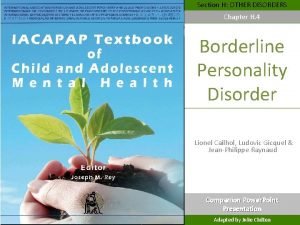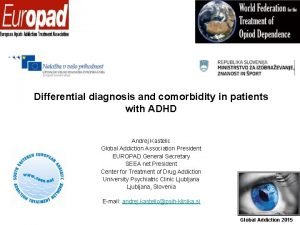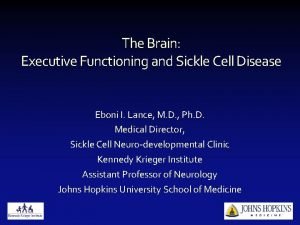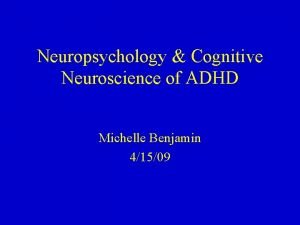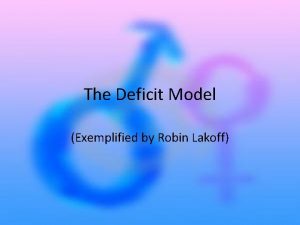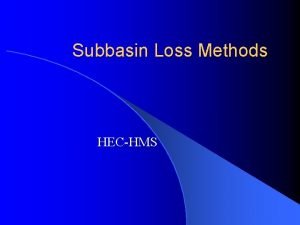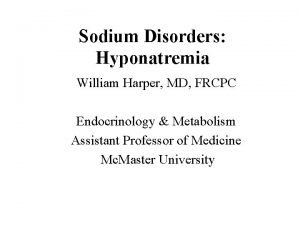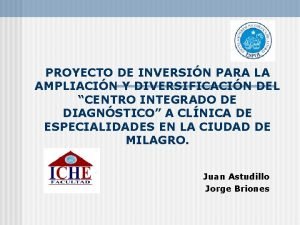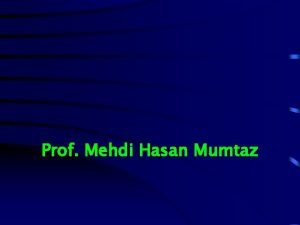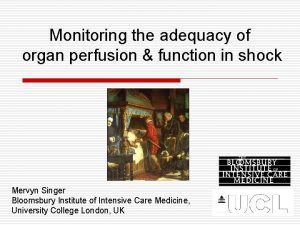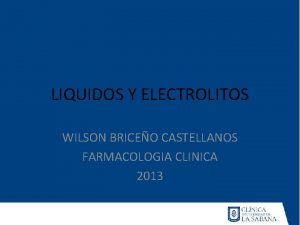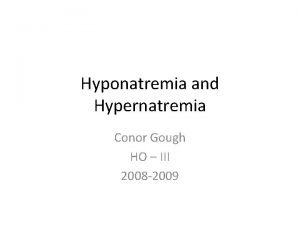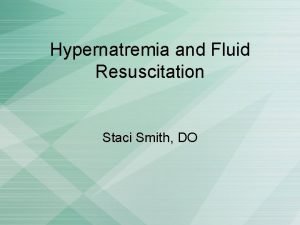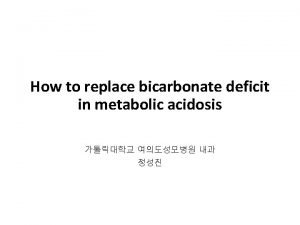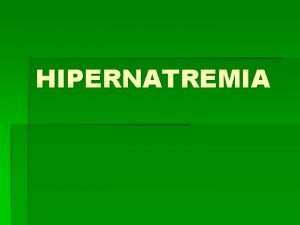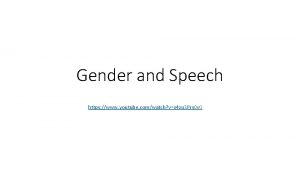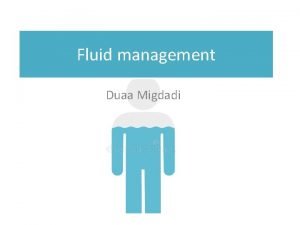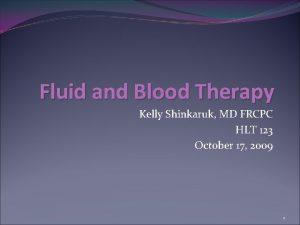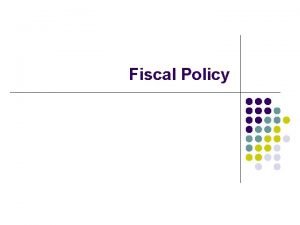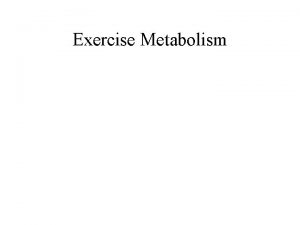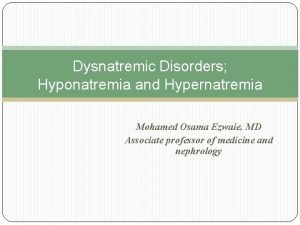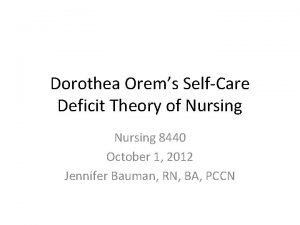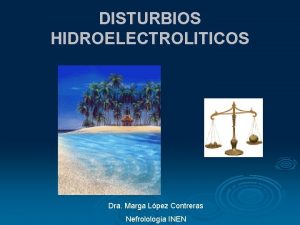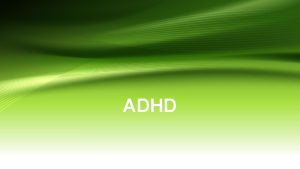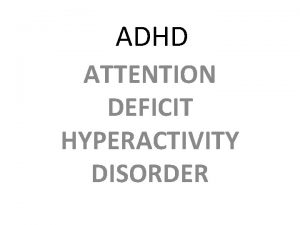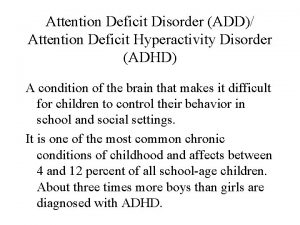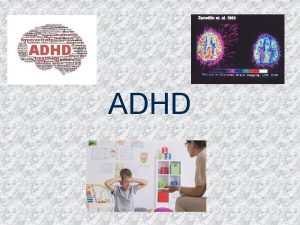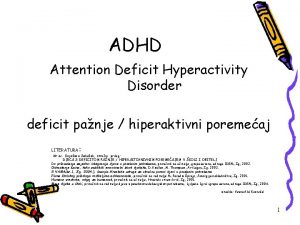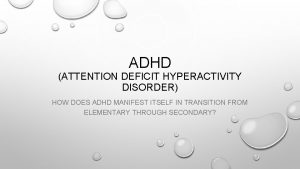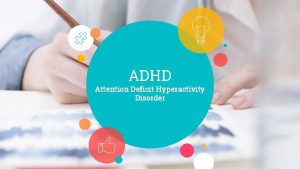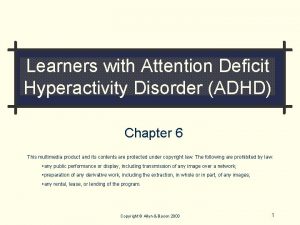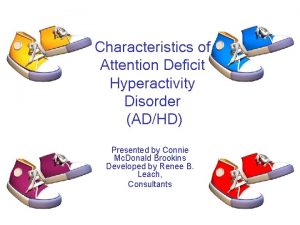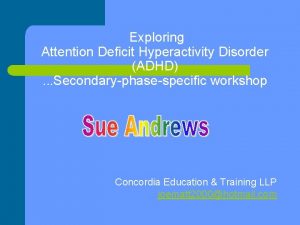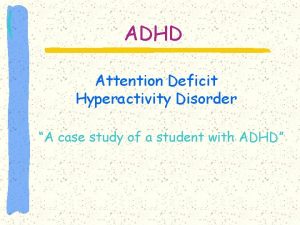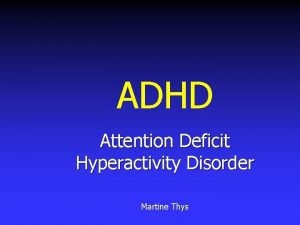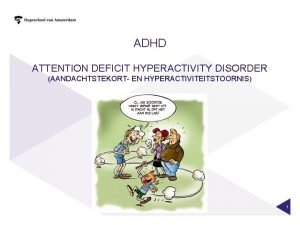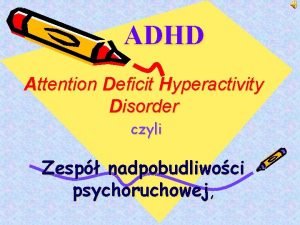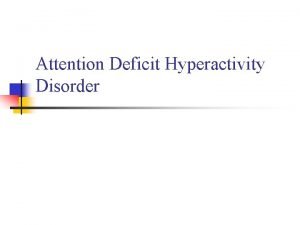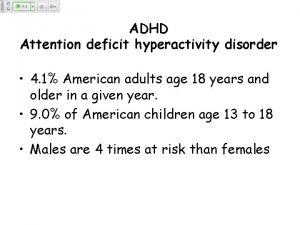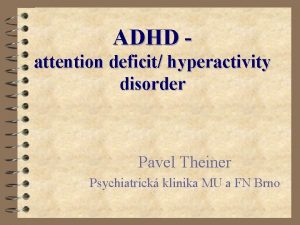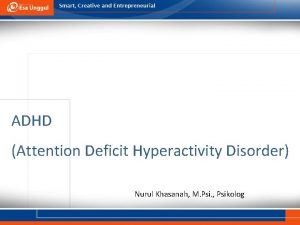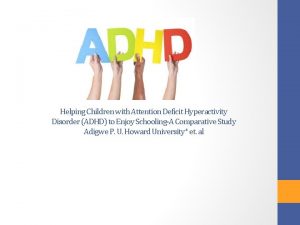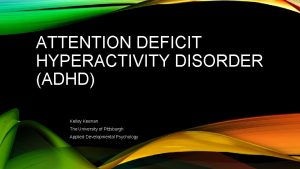ATTENTION DEFICIT HYPERACTIVITY DISORDER ADHD INTRODUCTION ADHD is

































- Slides: 33

ATTENTION DEFICIT HYPERACTIVITY DISORDER (ADHD)

INTRODUCTION : ¶ ADHD is the most common neurobehavioral disorder of childhood, among the most prevalent chronic health conditions affecting school-aged children, and the most extensively studied mental disorder of childhood. ¶ ADHD is characterized by inattention, including increased distractibility and difficulty sustaining attention; poor impulse control and decreased selfinhibitory capacity; and motor over activity and motor restlessness.

¶ Affected children commonly experience üacademic underachievement, üproblems with interpersonal relationships with family members and peers. ülow self-esteem. ¶ ADHD often co-occurs with other emotional, behavioral, language, and learning disorders

EPIDEMIOLOGY: v Studies of the prevalence of ADHD across the globe have generally reported that 9% of schoolage children are affected, although rates vary considerably by country. v The prevalence rate in adolescent samples is 2 -6%.

HISTORY OF ADHD: @ 1940 s: Minimal Brain Damage @ 1960 s: Minimal Brain Dysfunction @ 1970 s: Hyperkinesia @ 1980: Attention-Deficit Disorder Õ With or Without Hyperactivity @ 1987: Attention Deficit Hyperactivity Disorder @ 1994 (DSM IV): ADHD Õ Primarily Inattentive Õ Primarily Hyperactive Õ Combined Type

Diagnosing ADHD: DSM-V @ Inattention: (A 1) Persisted for at least 6 months to a degree that is inconsistent with developmental level and that negatively impacts directly on social and academic/occupati onal activities ' ' ' ' ' Lacks attention to detail; makes careless mistakes. has difficulty sustaining attention doesn’t seem to listen. fails to follow through/fails to finish instructions or schoolwork. has difficulty organizing tasks. avoids tasks requiring mental effort. often loses items necessary for completing a task. easily distracted. is forgetful in daily activities.

Diagnosing ADHD: DSM-V @ Hyperactivity/ Impulsivity: (A 2) ' ' ' Persisted for at least 6 months to a degree that is inconsistent with developmental level and that negatively impacts directly on social and academic/occupatio nal activities ' ' ' Fidgets or squirms excessively leaves seat when inappropriate runs about/climbs extensively when inappropriate has difficulty playing quietly often “on the go” or “driven by a motor” talks excessively blurts out answers before question is finished cannot await turn interrupts or intrudes on others

Diagnosing ADHD: DSM-V B. Several inattentive or hyperactive-impulsive symptoms were present prior to age 12 years. C. Several inattentive or hyperactive-impulsive symptoms are present in two or more settings. D. There must be clear evidence of clinically significant impairment in social, academic, or occupational functioning. E. Symptoms do not occur exclusively during the course of a pervasive developmental disorder, schizophrenia, or other psychotic disorder, and are not better accounted for by another mental disorder (e. g. , mood disorder, anxiety disorder, dissociative disorder, personality disorder).

Diagnosing ADHD: DSM-V Specify whether: • Combined presentation: If both Criterion A 1 (inattention) and Criterion A 2 (hyperactivityimpulsivity) are met for the past 6 months. • Predominantly inattentive presentation: If Criterion A 1 (inattention) is met but Criterion A 2 (hyperactivity -impulsivity) is not met for the past 6 months. • Predominantly hyperactive/impulsive presentation: If Criterion A 2 (hyperactivity-impulsivity) is met and Criterion A 1 (inattention) is not met for the past 6 months.

Diagnosing ADHD: DSM-V Specify if: • In partial remission: When full criteria were previously met, fewer than the full criteria have been met for the past 6 months, and the symptoms still result in impairment in social, academic, or occupational functioning.

Diagnosing ADHD: DSM-V Specify current severity: • Mild: Few, if any, symptoms in excess of those required to make the diagnosis are present, and symptoms result in no more than minor impairments in social or occupational functioning. • Moderate: Symptoms or functional impairment between “mild” and “severe” are present. • Severe: Many symptoms in excess of those required to make the diagnosis, or several symptoms that are particularly severe, are present, or the symptoms result in marked impairment in social or occupational functioning NOTE: . For older adolescents and adults (age 17 and older), at least five symptoms of A 1 or A 2 are required.

ETIOLOGY : • No single factor determines the expression of ADHD; • Mothers of children with ADHD are more likely to experience birth complications, such as toxaemia, lengthy labour, and complicated delivery. • Maternal smoking and alcohol use during pregnancy and prenatal or postnatal exposure to lead are commonly linked the development of ADHD. • There is a strong genetic component to ADHD. [dopamine transporter gene (DAT 1) and a particular form of the dopamine 4 receptor gene (DRD 4)]. There are some other genes that might contribute to ADHD.

ETIOLOGY : (CONT. ) • Severe traumatic brain injury with subsequent onset of substantial symptoms of impulsivity and inattention are reported in some children. • Structural or functional abnormalities have been identified in children with ADHD without pre-existing identifiable brain injury. These include dysregulation of the frontal subcortical circuits, small cortical volumes in this region, widespread small-volume reduction throughout the brain. abnormalities of the cerebellum. • Psychosocial family stressors can also contribute to or exacerbate the symptoms of ADHD.

PATHOGENESIS �Lower activity in brain regions associated with executive function (particularly abnormalities in frontostriatal circuit): �Prefrontal cortex �Basal ganglia �Cerebellum(vermis) �These areas of the brain are associated with executive function abilities: q Attention, spatial working memory, and short-term memory. q Response inhibition and set shifting.

Cont. • Abnormal central dopaminergic and noradrenergic tone. ¶ Dopamine has been associated with approach and pleasure-seeking behaviors. ¶ Norepinephrine plays a role in emotional/ behavioral regulation. • Smaller brain volume in prefrontal cortex, caudate nucleus, and vermis of the cerebellum. (a 5 -10% reduction in these brain structures)

A Possible Developmental Pathway for ADHD From Mash & Wolfe, 2007

DIAGNOSIS : • A diagnosis of ADHD is made primarily in clinical settings after a thorough evaluation, including – a careful history and clinical interview to rule in or to identify other causes or contributing factors; – completion of behavior rating scales; – a physical examination; – any necessary or indicated laboratory tests. • It is important to systematically gather and evaluate information from a variety of sources, including the child, parents, teachers, physicians, and when appropriate other caretakers.

Clinical Interview and History: ¶ history of the presenting problems, ¶ growth and development, ¶ pregnancy complications, such as maternal illness (eclampsia, diabetes), ¶ maternal smoking, alcohol, or illicit drug use. ¶ The perinatal period-- presence of labor problems, delivery complications, prematurity, jaundice, and low birth weight. ¶ Disruptive social factors, such as family discord, situational stress, and abuse or neglect. ¶ A family history of 1 st-degree relatives with ADHD, mood or anxiety disorders, learning disability, antisocial disorder, or alcohol or substance abuse (indicate an increased risk of ADHD and/or comorbid conditions)

Behavior Rating Scales: • Behavior rating scales are useful in establishing the magnitude of the symptoms, but are not sufficient alone to make a diagnosis of ADHD. • Many scales available – Conners Comprehensive Behavior Rating Scales (Conners CBRS)-- 6 to 18 years for teacher forms and parent forms & 8 to 18 years for self-report forms – Connors-EC for ages 2 -6 yrs – Connors Comprehensive and ADHD Rating Scale IV for ages 4 -5 yrs – Connors-3 for ages 6 -18 yrs – Academic Performance Rating Scale for grades 1 -6

PHYSICAL EXAMINATION AND LABORATORY FINDINGS • To rule out physical disorders that can mimic the symptoms of ADHD. • To identifies other physical problems that increase the risk of serious adverse events when a stimulant medication used. Exploration of cardiac status as well as monitoring of height and weight. • identify any possible vision or hearing problems. • testing for elevated lead levels in children those who are exposed to environmental factors that might put them at risk (substandard housing, old paint).

DIFFERENTIAL DIAGNOSIS • Chronic illnesses, such as migraine headaches, absence seizures, asthma and allergies, hematologic disorders, diabetes, childhood cancer, can impair children's attention and school performance, either because of the disease itself or because of the medications used to treat or control the underlying illness (medications for asthma, steroids, anticonvulsants, antihistamines). • In older children and adolescents, substance abuse can result in declining school performance and inattentive behavior. • Sleep disorders, including those secondary to chronic upper airway obstruction from enlarged tonsils and adenoids, often result in behavioral and emotional symptoms.

• Depression and anxiety disorders can cause many of the same symptoms as ADHD, but can also be comorbid conditions. • Obsessive-compulsive disorder can mimic ADHD, particularly when recurrent and persistent thoughts, impulses, or images are intrusive and interfere with normal daily activities. • Adjustment disorders secondary to – major life stresses (death of a close family member, parents’ divorce, family violence, parents’ substance abuse, a move) – parent-child relationship disorders involving conflicts over discipline, overt child abuse and/or neglect, or overprotection.

Comorbid disorders: Prevalence of comorbid disorders for children with ADHD vs those without Larson et al, 2007

TREATMENT : No treatments have been found to cure this disorder, but many treatments exist results in the greatest degree of improvement in the symptoms of the disorder. Psychosocial Treatments • The parents and child should be educated with regard to the ways ADHD can affect learning, behavior, self-esteem, social skills, and family function. • The clinician should set goals for the family to improve the child's interpersonal relationships, develop study skills, and decrease disruptive behaviors.

Behaviorally Oriented Treatments : • The goal of such treatment is for the clinician to identify targeted behaviors that cause impairment in the child's life (disruptive behavior, difficulty in completing homework, failure to obey home or school rules) • The clinician should guide the parents and teachers in implementing rules, consequences, and rewards to encourage desired behaviors. • Behavioral interventions are only modestly successful at improving behavior, but they may be particularly useful for children with complex comorbidities and family stressors, when combined with medication.

Medications : The most widely used medications are the pre synaptic dopaminergic agonists, commonly called psychostimulant medications ¶ Over the first 4 wk of treatment, the physician should increase the medication dose as tolerated (keeping side effects minimal to absent) to achieve maximum benefit. ¶ If this strategy does not yield satisfactory results, or if side effects prevent further dose adjustment in the presence of persisting symptoms, the clinician should use an alternative class of stimulants that was not used previously. ¶ If satisfactory treatment results are not obtained with the second stimulant, clinicians may choose to prescribe atomoxetine, a noradrenergic reuptake inhibitor. .

STIMULANTS: Methylphenidate: • Available in immediate and sustained release. • Absorption: From the GI tract, slow and incomplete • Dose(Ritalin): 5 mg (0. 3 mg/kg/dose) PO BID before breakfast and lunch. – Increase by 5 -10 mg/day (0. 2 mg/kg/day) at weekly intervals. – Max = 60 mg/day (2 mg/kg/day). • Once dose is determined, can switch to longer acting agent (Concerta , Medikinet)

Side effect of stimulant • Common: Anorexia, Sleep disturbance, Weight loss, Nervousness/ Restlessness, Growth retardation Increased blood pressure. • Severe: Tics, Arrhythmia, Psychosis, Sudden cardiac death, drug abuse potential.

NON-STIMULANTS • Usually second-line treatments – If stimulants are poorly tolerated or ineffective – As monotherapy or adjunct to stimulants Atomoxetine • MOA: selective nor epinephrine reuptake inhibitor. • Second-line treatment or alternative for patients with history of drug abuse. • Dose: 0. 5 mg/kg, then titrate up every 3 days to 1. 2 mg/kg in either 1 or 2 daily doses • Max = 1. 4 mg/kg or 100 mg (whichever is less) • Side Effects: – Common: weight loss, abdominal pain, appetite suppression, sleep disturbance – Serious: rare but severe liver injury – suicidal ideation

• Clonidine and Guanfacine – MOA: alpha-2 adrenergic agonist. – Provides modest reduction in ADHD symptoms by reducing impulsivity, hyperactivity and improving sleep. – Must taper slowly- risk for rebound hypertension. • Desipramine – MOA: inhibit NE and serotonin. – SE: anticholinergic effects, lowers seizure threshold, CV effects. • Bupropion – MOA: inhibits NE and DA. – Equivalent to methylphenidate. – SE: tics, lowers seizure threshold. • Others-- Iron May augment effects of stimulant therapy in adolescent patients with low ferritin.

Follow up: – Every 1 -3 weeks during initial titration. – Every 3 -6 months thereafter. • Assess treatment response through validated behavioral ADHD rating scales (Patients, parents and teachers) • Monitor height and weight during stimulant therapy Stopping Therapy • Consider stopping if patient is stable and doing well. Stop for 1 -4 weeks then reevaluate.

PROGNOSIS • From 60 -80% of children with ADHD continue to experience symptoms in adolescence, and up to 4060% of adolescents exhibit ADHD symptoms into adulthood. • In children with ADHD, a reduction in hyperactive behavior often occurs with age. Other symptoms become more prominent with age, such as inattention, impulsivity, and disorganization. • A variety of risk factors can affect children with untreated ADHD as they become adults. These risk factors include engaging in risk-taking behaviors (sexual activity, delinquent behaviors, substance use), educational underachievement or employment difficulties, and relationship difficulties.

Behavioral Treatment Components • • • Psychoeducation about ADHD Structure/routines Clear rules/expectations Attending/rewards Planned ignoring Effective commands Time out/loss of privileges Point/token systems Daily school-home report card Intensive summer treatment programs
 Adhd and borderline personality disorder
Adhd and borderline personality disorder Adhd vs bipolar
Adhd vs bipolar Is adhd a neurological disorder
Is adhd a neurological disorder Autism spectrum disorder adhd
Autism spectrum disorder adhd Somatic symptom disorder vs factitious disorder
Somatic symptom disorder vs factitious disorder Michelle benjamin phd
Michelle benjamin phd Attention getter for argumentative essay
Attention getter for argumentative essay Self introduction speech attention getters
Self introduction speech attention getters Robin lakoff deficit theory
Robin lakoff deficit theory Deficit and constant loss method
Deficit and constant loss method Cerebral salt wasting
Cerebral salt wasting Metodo de deficit acumulado
Metodo de deficit acumulado Base deficit formula
Base deficit formula Base deficit
Base deficit Formula deficit potasio
Formula deficit potasio Tigran becker
Tigran becker Sodium deficit
Sodium deficit Hypovolemia vs dehydration
Hypovolemia vs dehydration How to replace bicarbonate
How to replace bicarbonate Metodo de deficit acumulado
Metodo de deficit acumulado Formula de deficit de agua
Formula de deficit de agua Pamela fishman gender theory
Pamela fishman gender theory Metodo de deficit acumulado
Metodo de deficit acumulado Fluid deficit calculation
Fluid deficit calculation Maintenance fluid formula 4-2-1
Maintenance fluid formula 4-2-1 What is fiscal deficit
What is fiscal deficit The term oxygen deficit refers to the
The term oxygen deficit refers to the Metodo de deficit acumulado
Metodo de deficit acumulado Metodo de deficit acumulado
Metodo de deficit acumulado Ejercicios resueltos de balanza de pagos
Ejercicios resueltos de balanza de pagos Sodium correction rate for hyponatremia
Sodium correction rate for hyponatremia Dka criteria
Dka criteria Dorothea orems
Dorothea orems Insulid
Insulid
